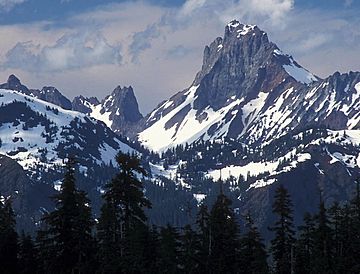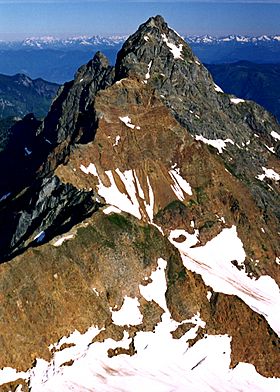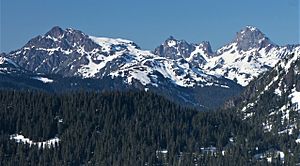American Border Peak facts for kids
Quick facts for kids American Border Peak |
|
|---|---|

American Border Peak, south aspect
|
|
| Highest point | |
| Elevation | 7,998 ft (2,438 m) NAVD 88 |
| Prominence | 2,794 ft (852 m) |
| Isolation | 11.56 mi (18.60 km) |
| Parent peak | Mount Shuksan |
| Geography | |
| Location |
|
| Parent range | North Cascades |
| Topo map | USGS Mt. Larrabee |
| Climbing | |
| First ascent | September 14, 1930, by Alec Dalgleish, Tom Fyles, Stan Henderson, R. A. Fraser |
| Easiest route | Southeast face (Exposed scramble) |
American Border Peak is a tall mountain located in Washington state. It sits right near the Canada–United States border. It has a "sister" peak called Canadian Border Peak, which is just north of the border.
This mountain is part of the beautiful Mount Baker Wilderness. This area is also within the Mount Baker-Snoqualmie National Forest. It's also quite close to North Cascades National Park. American Border Peak is known for its impressive height and steep sides.
Weather at American Border Peak
American Border Peak is in a special climate zone called the marine west coast climate. This means it gets a lot of weather from the Pacific Ocean.
Most weather systems start over the Pacific Ocean. They then travel northeast towards the Cascade Mountains. When these weather systems reach the tall peaks of the Cascades, they are forced to rise. As they rise, they drop their moisture as rain or snow.
Because of this, the western side of the North Cascades gets a lot of rain and snow. This is especially true during the winter months. The climate here is mild because it's close to the ocean. Temperatures rarely go below 0°F (about -18°C) or above 80°F (about 27°C).
In winter, the weather is usually cloudy. But in summer, high-pressure systems over the Pacific Ocean bring clear skies. The snow here tends to be wet and heavy. This can sometimes lead to a high risk of avalanches.
How American Border Peak Formed

The North Cascades mountains have very rugged shapes. You can see sharp peaks, long ridges, and deep valleys carved by glaciers. These amazing landscapes were created by geological events over millions of years. These events also caused big changes in elevation. This led to different climates and types of plants in the area.
The Cascade Mountains began forming millions of years ago. This was during a time called the late Eocene Epoch. The North American Plate (a huge piece of Earth's crust) was slowly moving over the Pacific Plate. This movement caused many volcanic eruptions.
Also, small pieces of Earth's crust, called terranes, joined together. This helped create the North Cascades about 50 million years ago.
Later, during the Pleistocene period (over two million years ago), glaciers played a big role. These huge ice sheets moved forward and backward many times. As they moved, they scraped away the land. They left behind piles of rock debris. The "U"-shaped valleys you see today were carved by these glaciers.
The main forces that created the tall peaks and deep valleys of the North Cascades are:
- Uplift: When land is pushed upwards.
- Faulting: When cracks in the Earth's crust cause sections to move.
- Glaciation: The action of glaciers.




